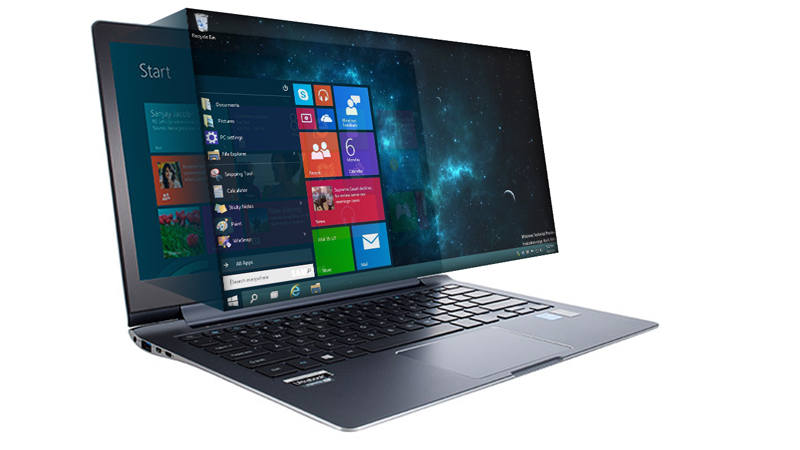Top three devices on which Microsoft Windows 10 will really shine

One great thing we can expect from the final inception of Windows 10, is that, in respect to previous versions of Windows, it already shows signs of how much less storage space the entire operating system requires.
For the past few months since we first installed Windows 10 on a separate hard drive, we ran it within the same hardware setup as our parallel Windows 7 Ultimate installation. Based on our observation so far, the difference in space requirements for the Windows folder in our installation of Windows 7 Ultimate, is well over 30GB, while Windows 10 barely reaches 21GB, in a comparably similar usage scenario, where apps and files are stored in a common external drive.
Another aspect we have been happy with, brought on by the latest build, is a boost in how fast the operating system gets ready for use, from a complete restart/clean boot. Prior to this last build, Windows 10 seemed to have a little trouble firing startup applications, particularly Google Drive, whose automatic file synchronization still holds up Windows 7 up to several minutes before the desktop becomes accessible. Currently, on the latest build of Windows 10, it seems Google Drive file synchronization is handled a lot better, and it’s capable of carrying on without freezing the desktop until it’s done.
Having experienced how much Windows 10 performance has improved since its first build, we have selected three portable devices where we believe Windows 10 will truly show its strength as an operating system.
This ultraportable 13 inches laptop is powered by the 5th generation of Intel core i5 and i7 processors, supports up to 16GB of RAM, and up to 512GB of SSD storage, which is plenty, considering how much less space the actual Windows 10 operating system needs, compared to Windows 7 or Windows 8.1, which are the current choices this device ships with.
Gestures in Windows 10, greatly enhance the experience, allowing the user to manage virtual desktops, switch applications and perform more actions, without keyboard shortcuts. This is where the multitouch display on the Toshiba Portege brings value to user experience. The Portege, in its detachable screen iteration, will offers to enhanced the experience, by making use of the automatic “Tablet Mode” in Windows 10.
The Portege also includes a fingerprint reader, a feature that will become increasingly relevant, since Microsoft has announced support for biometric recognition at login.
Otherwise known as the “Macbook Pro of Windows laptops”, the new iteration of the Samsung Ativ Book 9 would perfectly complement Windows 10. Powered by the 5th generation Intel core i7 processor, featuring clock speeds up to 2.9GHz, this laptop ships with 8GB DDR3 SDRAM 1600Mhz and 256GB SSD.
A massive resolution of 3200 x 1800 pixels, is delivered by the Intel HD Graphics 5500 hardware, on an ultra-sharp anti-glare 13.3 inches multi-touch display, capable of adjusting brightness levels according to the surrounding lighting conditions.
As for the Portege, we can see biometric login being a useful feature, running Windows 10, this time through the use of the 1.3MP webcam.
Security and performance are the keywords when it comes to Windows 10 running on a semi-rugged laptop. The specs on the Panasonic ToughBook 54 allow Windows 10 to make use of advanced features, especially when bringing this device to harsh environments.
Powered by an Intel Core i5 vPro processor, featuring clock speeds up to 2.9MHz, this laptop supports up to 16GB of SDRAM DDR3L 1600MHz, 256BG SSD, and up to 1TB 7200rpm HDD.
The features that really stand out in the ToughBook 54, aside from the FHD 1920 x 1080 pixels, 14 inches multi-touch display, which can also be used with a stylus, as well as through gloves, are the full array of built-in accessories, such as the integrated 1080p webcam, contact-less SmartCard/NFC reader and fingerprint reader for advanced biometric recognition and security.
The ToughBook’s built in GPS, and 4G LTE are also supported by Windows 10, for enhanced wireless connectivity and satellite navigation.
Getting Microsoft Windows 10
Windows 10’s official release is getting closer, at least judging by the increasing speed at which updates are being issued.
According to recent reports,users who already own Windows 7 and 8.1 licenses will be able to upgrade to Windows 10 for free, for a whole year, while owners of OEM/system builder licenses of Windows 7 or 8.1, as well as enterprise customers, will have to buy new licenses in order to upgrade to Windows 10.